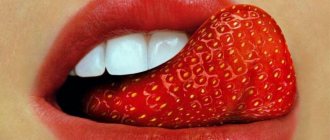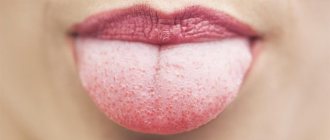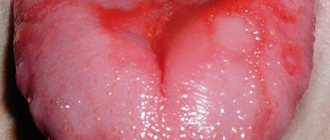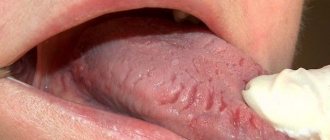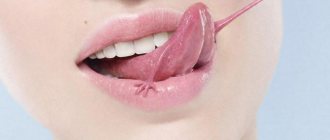- What does a normal tongue look like?
- White spots on a child's tongue
- Red spots on a child's tongue
- How to treat spots on the tongue
- Imudon® in the fight against inflammatory diseases
The tongue is considered an indicator of health, so the appearance of spots on it should alert parents, even in the absence of other manifestations. However, before you begin to calculate the reasons that caused the formation of plaque, analyze your baby’s diet. Very often, tongue spotting is caused by eating dyes or foods containing chemical dyes3.
Spots in the oral cavity of children are formed from the influence of various factors. This symptom does not always indicate a disease in the oral cavity. Parents' attentiveness to the baby's condition allows the disease to be quickly detected and eliminated.
What does a healthy tongue look like?
First, let's remind parents what a healthy tongue looks like. The following signs indicate the state of normality:
- the size is not increased;
- humidity is moderate;
- the color of the tongue is pale pink, without spots or grooves;
- sensitivity is normal, papillae are not enlarged;
- allow for a light coating that is easy to clean;
- There is no bad breath.
If, upon examination of the child, the condition of his tongue corresponds to the signs described above, there is no reason to worry and see a doctor.
Changes that should alert parents
In addition to changes in the color of the taste organ, parents should be wary of other accompanying symptoms, including:
- swelling, against which the imprints of teeth can be seen;
- insufficient moisture or obvious dryness of the surface of the tongue;
- enlarged papillae, especially pronounced in the root part;
- formation of persistent plaque on the surface of the tongue;
- burning sensation and impaired taste perception;
- the appearance of a specific odor from the mouth.
Parents can notice these changes during a visual inspection, which is best done in the morning in natural light. If the situation continues for a long time, the plaque thickens and the color of the tongue does not return to normal, there is every reason to consult a doctor to find out the reasons and identify hidden pathology.
Pimples on tongue
Pimples on the tongue are painful and cause discomfort, but they are easily treated and do not cause complications. A pimple on the tongue can appear for many reasons, most often due to microtrauma of the tongue, stomatitis or herpes. In principle, there cannot be acne on the tongue, since there are no sebaceous glands on it. Those formations that are mistaken for pimples are not actually pimples - they are not filled with purulent exudate. These are small swellings and ulcers on the surface of the tongue. They are white, pink, red, yellow, depending on the complexity of the disease and the cause of formation. Small pimples are very painful, they interfere with eating, talking and even bother the patient at rest.
White pimple on tongue
A white pimple on the tongue most often appears as a result of stomatitis or candidiasis. These two diseases are treated completely differently; you should consult a doctor at the first symptoms in order to correctly diagnose and prescribe treatment. Candidiasis is characterized by white pimples and a coating on the tongue, which in appearance resembles cottage cheese and covers the entire surface of the oral cavity. There are also white pimples on the base, tip and under the tongue.
With stomatitis, small pimples appear on the tongue. There are usually many of them, they can merge with each other. These small white pimples at the tip or root, at the base or underneath are very painful and itchy. The pain intensifies after eating. If such symptoms appear, you should consult a doctor to confirm the diagnosis and prescribe treatment. Treatment consists of antiseptic treatment of the surface of the oral cavity and lifestyle correction, since the main cause of stomatitis is insufficient oral hygiene.
Red pimple on tongue
Red pimples on the tongue are the main sign of glossitis, an inflammatory disease. Outwardly, they look like inflamed red dots that hurt.
Glossitis can appear for many reasons:
- Allergic reaction;
- alcohol abuse;
- eating too hot and spicy food;
- the presence of the herpes virus.
The appearance of yellow pimples on the tongue is usually not an independent disease. Often with stomatitis or candidiasis, the coating on the surface of the tongue takes on a yellowish rather than white tint. Yellow pimples most often also mean either candidiasis or stomatitis.
Pink pimples on the tongue , like yellow ones, are not an independent disease. Usually they are an early stage of glossitis, when the inflammatory process has not yet reached its peak. If pink acne appears, you should immediately consult a doctor for advice.
The main causes of acne:
Mechanical damage
In the process of chewing or biting food, we bite our tongue, resulting in a slight mechanical injury. The risk of surface damage increases when consuming hard foods with sharp edges (crackers, chips, seeds). A small painful swelling or bump forms at the site of the injury, which after some time turns into a white pimple.
You should exclude spicy and hot foods from your diet, carefully monitor oral hygiene, and after a few days the pimple will disappear on its own.
Allergic reaction
An allergic reaction is possible to food, medicine or toothpaste. This causes small white pimples and sores to form that hurt and irritate when eating or drinking liquids. If your doctor suspects an allergy, it is very important to identify the allergen and eliminate it from your diet.
Stomatitis
Stomatitis is a common cause of white or red pimples on the surface of the tongue. The main cause of stomatitis is insufficient oral hygiene, exposure to pathogenic bacteria on the mucous membranes due to dirty hands, unwashed fruits and vegetables. Most often, children suffer from stomatitis, because they tend to put everything in their mouth. At the first suspicion of stomatitis, you should consult a doctor, he will prescribe medications that relieve itching and soreness of the tongue, as well as promote the speedy healing of ulcers and pimples.
Herpes
Herpes can affect all mucous surfaces of the human body, including the oral cavity. In this case, watery pimples may appear on the tongue and inner surface of the cheeks. Without proper treatment, herpes can eventually affect the entire body, including the brain. Therefore, if you have a herpes virus, you should consult a doctor and undergo a course of antiherpetic therapy.
Poor nutrition
If you eat too much spicy and hot food, inflammation of the tongue, or glossitis, may occur. Drinking alcohol in large quantities, as well as smoking, can cause inflammation of the tongue. Therefore, when the first problems appear, you should immediately try to get rid of bad habits.
Pathologies of the patient's internal organs
Pimples on the tongue can be a manifestation of various diseases, including candidiasis or tuberculosis. If a pimple does not go away for a long time, be sure to consult a doctor.
Weakened immunity
If the immune system is weakened as a result of a previous illness or due to a lack of vitamins and microelements, small painful pimples may appear on the surface of the tongue. It is necessary to take immunomodulators, as well as drugs with lactobacilli to normalize intestinal function and correct the activity of the immune system.
You can only get rid of a pimple on your tongue using comprehensive measures. It is necessary to consult a doctor to determine the true cause of its occurrence. The oral cavity should be kept clean, preferably rinsed with a soda solution or a decoction of St. John's wort. It is also necessary to strengthen the immune system and limit the consumption of spicy and too hot foods so as not to irritate the inflamed nodule.
A pimple at the base of the tongue makes it difficult to swallow and even talk; it hurts and causes a lot of trouble. It could be stomatitis, a fungal infection, a sore throat or pharyngitis. Only an experienced doctor can make a correct diagnosis.
A pimple on the tip of the tongue can pop up at the site of a microtrauma as a result of an infection entering the wound.
In any case, it is advisable to consult a doctor and get tested to make an accurate diagnosis.
For any questions, please call: +7 (343) 2000 730; +7 We work daily, without breaks: Mon-Sat 09.00-21.00 Sun 10.00-20.00 We are waiting for you at the address: Ekaterinburg, st. Gottwald 14a, office 6. Dentistry "MK DENT"
A red or pale tongue is not the norm!
Both options indicate pathological changes occurring in the child’s body:
- A crimson-red tongue always indicates the presence of an infection (viral, bacterial or fungal). Most often it is tonsillitis, scarlet fever, stomatitis or glossitis.
- A red and shiny tongue is a sign of anemia, exhaustion and severe stomach disease;
- A cherry tint is a sign of influenza and measles, as well as general intoxication or kidney dysfunction;
- A bluish color indicates a lack of oxygen; there is reason to suspect disorders in the cardiovascular system or lungs;
- Purple color may indicate blood and lung diseases, heart failure.
- A too pale tongue, being penetrated by blood vessels, a priori cannot be lighter than blood. In most cases, this sign indicates exhaustion, deficiency of folic acid or vitamin B 12.
Let us remind parents that very often there may be a coating on the surface of the tongue, the color of which also has its own characteristics.
More rare situations
Yellow spots on a child’s tongue may indicate diseases of the digestive system1. Usually the problem manifests itself in the formation of a dense coating on the base of the tongue, which is difficult to remove. The cause should be sought with the help of a gastroenterologist.
Blue areas are extremely rare in childhood, as they signal problems with the cardiovascular system. Also, dark blue spots may just be hemangiomas that do not require any correction.
Bald spots are areas where taste buds are missing3. The child does not feel them, and they cannot be treated in any way, since the death of the papillae is irreversible. The main task of parents is to determine the reason for the formation of such areas.
Causes of tongue redness
All existing causes of external changes in the language, including its color, can be divided into two groups. The first group of factors are easily solvable problems that do not signal internal disorders and are not a cause for concern on the part of parents. These include:
- consumption of coloring foods and drinks,
- eating too hot (cold) food;
- mechanical trauma from a brush, teeth, lollipop, etc.
The second one combines negative causes that are inextricably linked with pathological processes that are hidden or obvious in the child’s body:
- inflammation of the taste buds;
- any inflammatory processes caused by viruses or infection;
- intoxication of the body due to poisoning;
- taking medications (antibiotics);
- allergic reaction to food, medications.
- lack of vitamins and microelements.
Only a doctor can identify the true cause of changes in the color and texture of the tongue. Parents should not engage in self-diagnosis and self-medication; this will only mask the problem and complicate the doctor’s work.
How to treat spots on the tongue?
Treatment of any changes in a child’s oral cavity should be based on eliminating the cause of the problem. Approaches to the treatment of spots on the tongue are varied, since not only dental diseases can cause them.
Most often, the child and parents are faced with stomatitis or a fungal infection of the oral cavity. Principles for treating this problem:
- careful adherence to oral hygiene;
- taking antibacterial or antiseptic drugs, most often local in the form of sprays and rinses;
- taking local antifungal agents (in case of candidiasis, but not for prevention);
- taking local immune activators.
In the case of spots on the tongue as a manifestation of an allergic reaction, you first need to determine what caused it and stop contact with the irritating substance. Additionally, antihistamines are used. In some cases, allergy symptoms appear due to incorrect, too rapid introduction of complementary foods to infants4.
If spots form due to a herpes infection, antiviral agents should be used, most often acyclovir drugs. Treatment of blisters and sores should be carried out using hydrogen peroxide, and then lubricated with an oil solution based on eucalyptus. Vitamin complexes and immune medications will help speed up recovery.
Spots that arise as a result of disturbances in the gastrointestinal tract disappear after exposure to the cause of the problem. Depending on the disease, the child may be prescribed medications that improve gallbladder function, normalize acidity in the stomach, probiotics and live beneficial bacteria to improve intestinal function.
What diseases does a red tongue hide?
A red tongue can be a symptom of diseases of various etiologies, including:
- angina;
- flu;
- chickenpox,
- scarlet fever;
- stomatitis;
- glossitis;
- pneumonia;
- Kawasaki disease;
- gastritis;
- severe poisoning;
- renal failure;
- vitamin deficiency (vitamin B deficiency).
As you can see, the list of diseases is quite wide and requires visiting not only an otolaryngologist, but also, if necessary, other specialized specialists: dentist, endocrinologist, gastroenterologist, etc.
